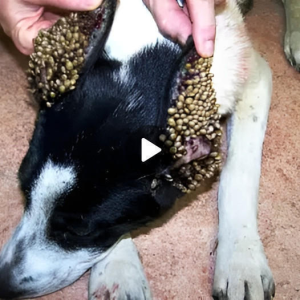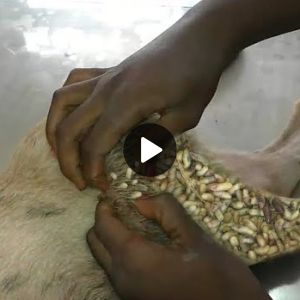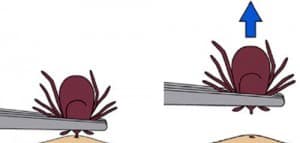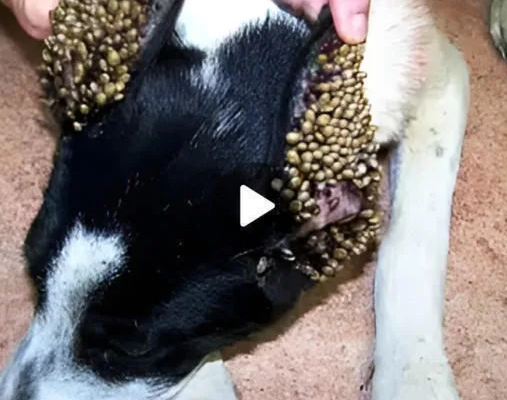
What Do Ticks on Dogs Look Like?
Ticks can be tricky to spot sometimes. Here’s what to look for when checking for ticks, as well as symptoms your dog may have been bitten.
Appearance

A feeding tick can often be mistaken for a mole or even a nipple on your dog’s body. Ticks bury their head under the skin as they feed, leaving their back end sticking out. Often, this looks like a hard, round, black or brown spot. As the tick feeds, it will begin to engorge with blood, growing in size. Once the tick is done feeding, it detaches from the host body, leaving behind a small wound where it fed.
Symptoms
Your dog may attempt to scratch or bite at a tick as it is feeding, as the process can be itchy or irritating. After the tick has left, you may also notice a small wound, or a “bulls-eye” red mark surrounding the bite site. Tick-borne illnesses can present with several similar symptoms as well. These include fever, lethargy, loss of appetite, physical pain, or paralysis. In addition, some diseases may cause internal organ damage such as kidney disease. These problems can present with changes in thirst, urination, and bowel or eating habits.
Treatment and Prevention of Ticks on Dogs
Thankfully, there are many preventive medications available to help reduce or completely stop ticks from jumping on your dog. Here are some of the most common methods of treating ticks on dogs.
Over the Counter and Prescription Medications

Most over the counter and prescription flea medications are also formulated to prevent and treat ticks. These include the most popular brands such as Frontline and Advantage. Similar to their flea counterparts, these topical medications work by killing the tick when it hops on and attempts to feed before it has a chance to bite. Monthly oral medications, such as NexGard, also provide similar tick preventives in a monthly chewable.
Collar products, such as Seresto, work by repelling ticks before they hop onto the body and killing them once they do. Tick collars are very popular and effective for working dogs, such as hunting or tracking dogs that frequent areas where ticks live. Tick sprays are also beneficial for treating the environment. These sprays kill and repel ticks. Keeping frequented areas such as your backyard free of brush, large leaf piles, and tall grass can also reduce the tick population naturally.
Natural Remedies
Most natural tick prevention remedies are for treating the environment rather than your dog. It is always best to check if a product or remedy is safe for use on your dog’s skin before using it. Ticks are naturally repelled by citruses, such as lemon or orange scents. Essential oils such as peppermint, cedar, and citrus can also be sprayed in areas ticks frequent to help repel them. However, it is best to move any pets to well-ventilated areas if using them indoors. Several natural shampoos can also be used on your dog to repel ticks.

If you do spot a tick on your dog’s body, don’t panic. If tweezers are used, do not squeeze as this can release blood (and disease vectors) into your dog’s body. Tweezing can also accidentally detach the tick’s head, leaving it embedded under your dog’s skin, which may lead to an infection. Instead, try to get the tweezers as close to your dog’s skin as possible. Special tick-removal hooks can also be used and should be kept on hand if you frequent areas where ticks live.
Rocky Mountain Spotted Fever
Caused by the bacteria Rickettsia rickettsii, Rocky Mountain Spotted Fever (RMSF) was most prevalent in the Rocky Mountains. However, it has since spread across most of North America and can be carried by a number of different tick species. Arizona and the Southwest have one of the highest rates of this disease in dogs and humans. As with most tick-borne illnesses, symptoms include fever, lethargy, and weight loss. In addition, RMSF can also cause abnormal bleeding externally and internally.
A complete history, including any incidence of tick bites, as well as blood work to check for overall illnesses, clotting factors, and more can determine if RMSF is present. Your veterinarian may also suggest X-rays or ultrasound to check for internal organ damage. For specific confirmation of the disease, a sample of blood can also be sent out to a lab for an antibody titer.
As with most tick-borne illnesses, strong antibiotics over a course of 10-28 days is the best treatment. If your dog is also showing signs of secondary issues, hospitalization, supportive care, and additional medications are recomme





